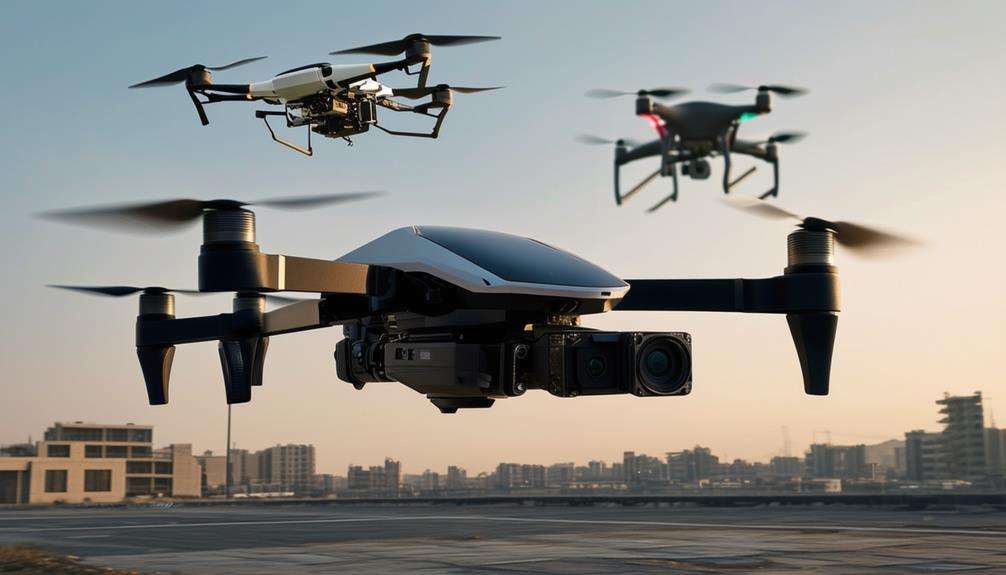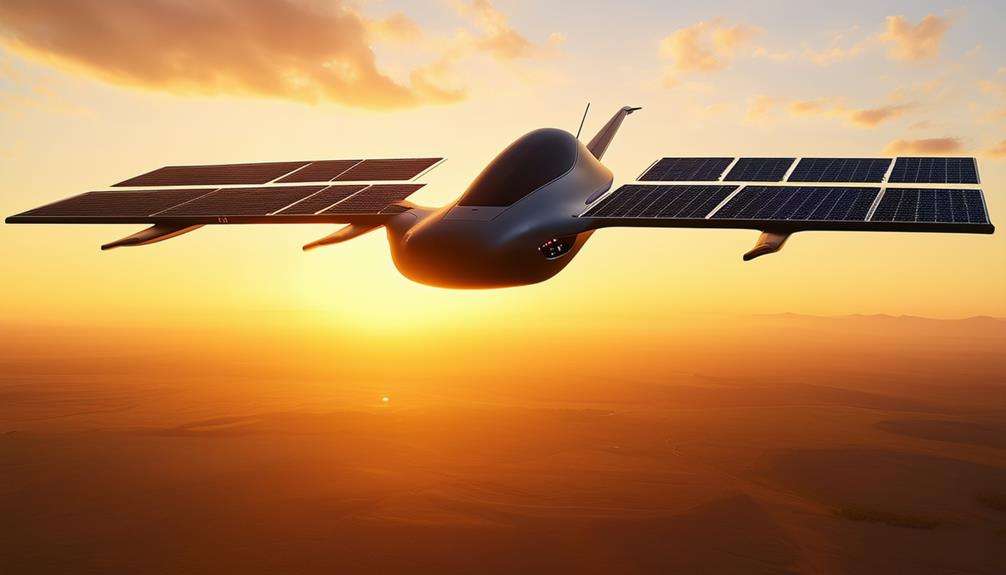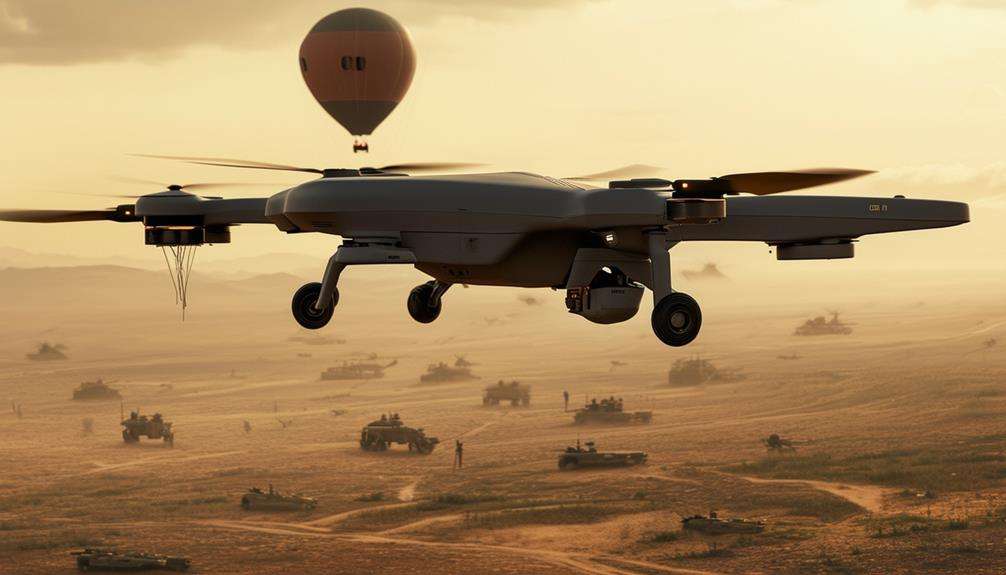How VTOL (Vertical Take-Off and Landing) Drones Work
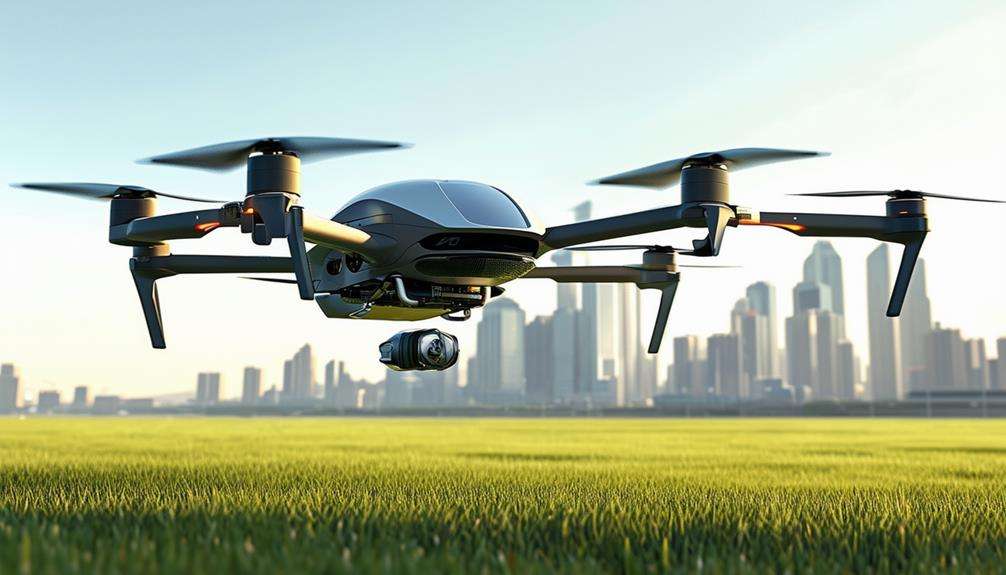
VTOL (Vertical Take-Off and Landing) drones combine the vertical lift of a helicopter with the efficient horizontal flight of a plane. These drones utilize specialized propulsion systems, such as rotors or propellers, to achieve this dual capability.
The key to their functionality lies in the flight controllers, sensors, and algorithms that manage in-flight dynamics and ensure stability. But how do these components work together to transition from vertical to horizontal flight? Let's explore the complex mechanics that make VTOL drones so versatile and efficient.
The Basics of VTOL Drones
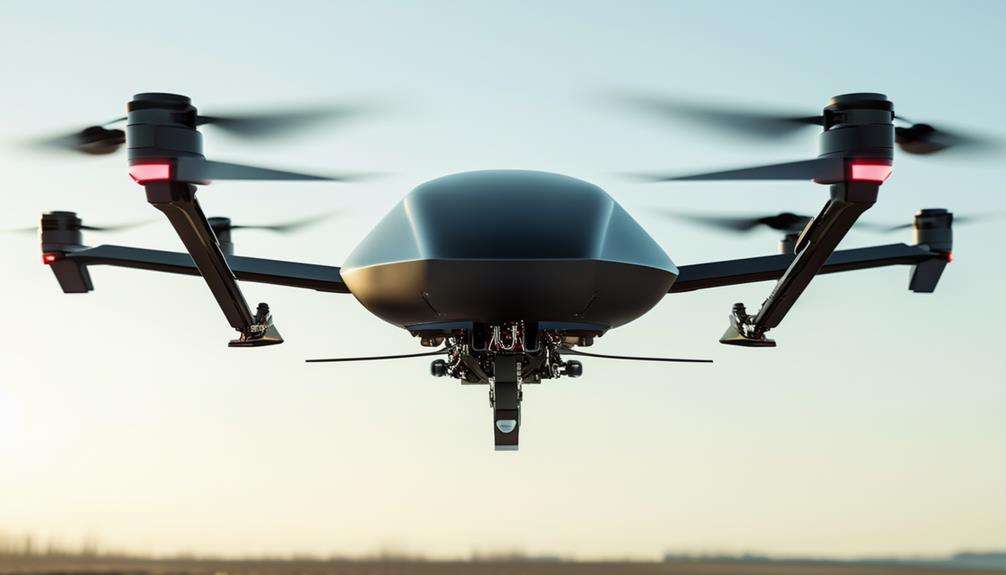
VTOL drones, or Vertical Take-Off and Landing drones, are highly versatile and can operate in confined spaces without the need for runways. These drones excel in vertical takeoff, hovering, and seamlessly transitioning to horizontal flight, thanks to advanced propulsion systems that provide the necessary lift and thrust.
Several types of VTOL drones are designed for specific missions. Multi-rotor VTOL drones use multiple rotors for lift, while tilt-rotor drones adjust their rotor angles to switch between vertical and horizontal flight modes. Tail-sitter VTOL drones take off and land vertically on their tail before transitioning to forward flight.
The propulsion systems in VTOL drones are crucial to their functionality. They can range from electric motors, which offer quieter operations and lower maintenance, to internal combustion engines, which provide longer flight times and higher speeds. Understanding these basics will give you a solid foundation on the versatility and functionality of VTOL drones.
Key Components of VTOL Drones
Understanding the key components of VTOL (Vertical Take-Off and Landing) drones highlights their complex engineering and versatility. These drones rely on several critical parts to perform their specialized functions:
- Rotors/Propellers: Essential for vertical take-off and landing, these components provide the necessary lift to get the drone off the ground and back down safely.
- Fixed Wings/Airfoils: Once airborne, VTOL drones switch to using fixed wings or airfoils for efficient horizontal flight. These wings help the drone glide through the air with stability, conserving energy compared to using rotors alone.
- Flight Controllers: These are crucial for managing the drone's movements, ensuring stability and responsiveness during different flight modes. Coupled with sensors, flight controllers help the drone navigate and adapt to various conditions seamlessly.
- Batteries/Power Systems: These provide the essential energy for propulsion and operation. Reliable batteries are indispensable for sustaining flight.
- Advanced Technologies: VTOL drones often incorporate GPS, cameras, and obstacle avoidance systems. These features enhance performance and functionality, making them versatile tools for a range of applications.
Take-Off Mechanisms
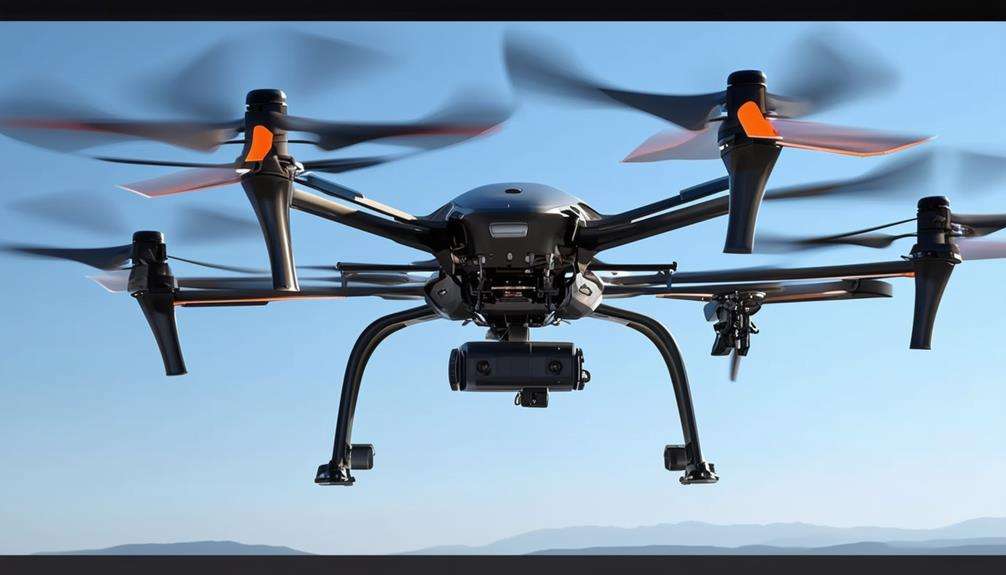
VTOL (Vertical Take-Off and Landing) drones use propellers or rotors to generate the vertical lift required for a smooth take-off. Unlike traditional aircraft, VTOL drones don't need a runway; they can adjust their thrust direction to lift off vertically. This capability makes them highly versatile, enabling operation in confined spaces or urban environments.
By leveraging propellers or rotors, VTOL drones can produce sufficient vertical lift to overcome gravity. The success of their take-off hinges on their ability to precisely control thrust direction. This allows for launches from challenging locations such as narrow alleyways or small clearings in forests.
Equipped with advanced control systems, VTOL drones ensure stable take-offs by continuously monitoring and adjusting their position and balance. This precision is critical for accessing remote or hard-to-reach areas efficiently. Whether conducting surveys in dense urban areas or delivering supplies to remote outposts, VTOL drones provide a reliable solution for vertical take-off and landing.
In-Flight Dynamics
When examining the in-flight dynamics of VTOL (Vertical Take-Off and Landing) drones, it's crucial to understand how they maintain stability during hovering and transition seamlessly to forward flight. Stability control is vital for executing precise maneuvers, and the transition phase requires intelligent adjustments to propeller speeds and airfoil configurations. A comprehensive understanding of these dynamics enables the optimization of flight performance and ensures mission reliability.
Hovering and Stability Control
VTOL drones achieve their remarkable hovering ability through precise control of thrust and airflow, facilitated by a sophisticated system of sensors and flight controllers. These drones rely on a complex interplay between various components to maintain stability and control during flight. Sensors continuously monitor the drone's orientation and position, feeding data to flight controllers that use advanced algorithms for real-time adjustments.
Flight controllers analyze data from gyroscopes, accelerometers, and barometers to ensure the drone remains stable even when facing external factors like wind and turbulence. Feedback loops are integral to this process, constantly adjusting rotor speeds and angles to maintain steady hovering.
Here's how VTOL drones manage hovering and stability control:
- Sensors: Monitor orientation, position, and environmental conditions.
- Flight Controllers: Process sensor data and execute control commands.
- Algorithms: Calculate necessary adjustments for stability.
- Feedback Loops: Continuously refine rotor speeds and angles for precise control.
- Thrust Control: Adjust power to each rotor to counteract disturbances.
Transition to Forward Flight
During the transition to forward flight, drones adjust their rotor angles to seamlessly switch from vertical to horizontal movement. This critical phase requires precise aerodynamic controls to maintain stability. The flight control systems play a key role, orchestrating the gradual change in rotor angles and ensuring a smooth transition between flight modes.
As the drone increases its forward speed, it undergoes an attitude adjustment, tilting its body to reduce drag and optimize lift. Control surfaces, such as ailerons and rudders, become more active during this phase, contributing to efficient forward flight. These surfaces work in tandem with aerodynamic principles to keep the drone stable and responsive to pilot commands.
Throughout this transition, the flight control systems continuously monitor and adjust the drone's parameters to maintain peak performance. They ensure that the drone's lift, stability, and control aren't compromised, making the phase as smooth as possible. Leveraging advanced technology and aerodynamic insights, VTOL drones can successfully switch from hovering to dynamic forward flight with precision and ease.
Landing Techniques
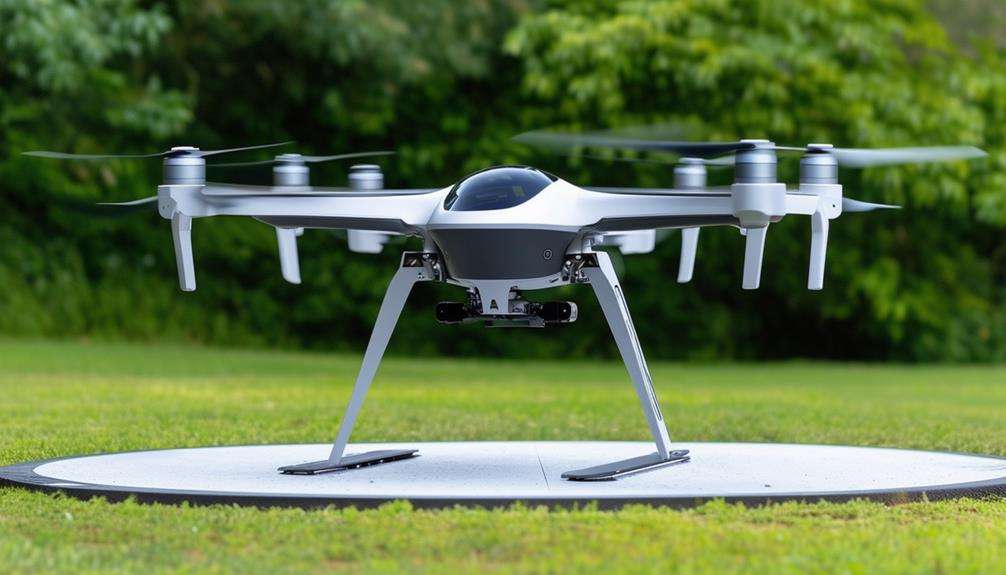
Perfecting vertical landing techniques ensures that VTOL drones land safely and efficiently without needing a runway. Mastering these techniques allows your drone to descend smoothly and land with precision.
Vertical landing involves carefully adjusting the drone's descent speed and angle to maintain stability. The propulsion systems play a crucial role by providing the right amount of thrust to counteract gravity while enabling a controlled descent.
To achieve a stable vertical landing, VTOL drones use a combination of sensors and GPS to monitor their position and altitude. These tools help the drone make real-time adjustments to its descent speed and angle, ensuring a steady approach to the landing surface. Advanced algorithms process data from the sensors, making necessary corrections to maintain stability.
Key components involved in vertical landing techniques include:
- Descent Speed Control: Adjusts the rate of descent for a smooth landing.
- Propulsion Systems: Modulates thrust to counteract gravity and stabilize the drone.
- Stability Maintenance: Keeps the drone level during descent.
- Sensors: Provide real-time data on altitude and position.
- GPS: Assists in precise positioning for accurate landings.
Manual Control Options
After mastering vertical landing techniques, you can explore manual control options that offer precise adjustments and enhanced maneuverability for VTOL drones. These options typically involve remote controllers equipped with joysticks, buttons, and switches, enabling precise piloting.
Manual control allows for fine adjustments to the drone's throttle, pitch, roll, and yaw. Adjusting the throttle controls altitude, enabling smooth ascents and descents. Manipulating the pitch tilts the drone forward or backward, while roll allows it to lean side to side. Yaw control rotates the drone around its vertical axis, facilitating directional changes without altering altitude.
These controls are crucial for tasks requiring high precision, such as aerial photography, mapping, surveillance, or inspection. Training and practice are essential to mastering these controls. With enough practice, manual control offers unmatched flexibility and maneuverability. Whether capturing stunning aerial shots or conducting detailed inspections, these controls ensure safe and efficient VTOL drone operation.
Advantages of VTOL Drones
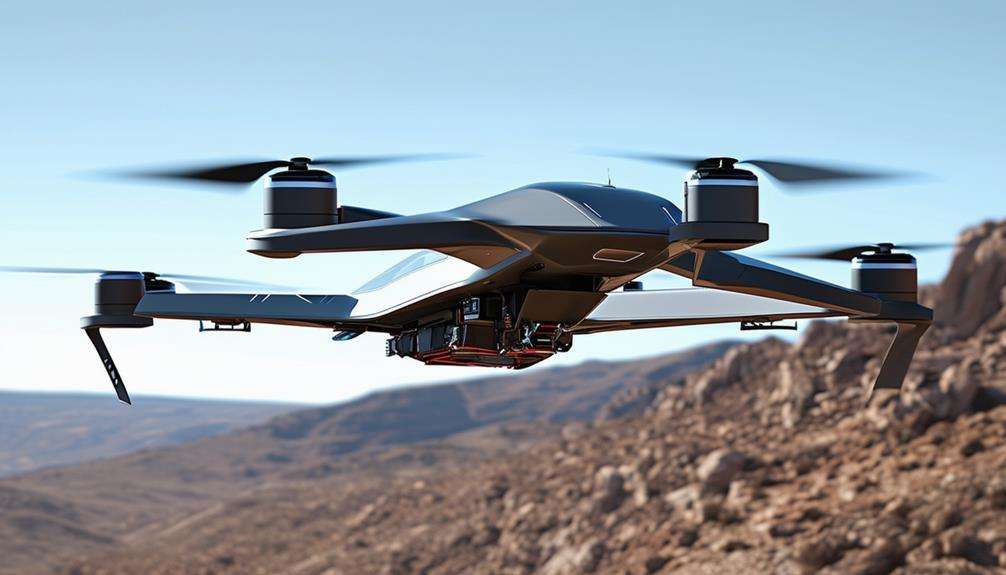
VTOL drones offer versatile deployment options, enabling takeoff and landing in almost any location, including tight urban spaces. Their enhanced maneuverability facilitates navigation through complex terrain. Additionally, their efficient energy usage results in longer flight times and reduced operational costs.
Versatile Deployment Options
VTOL drones transform deployment possibilities by enabling precise takeoffs and landings in confined spaces, urban areas, and remote locations. These versatile drones are ideal for situations where traditional UAVs are limited. With VTOL drones, you achieve mission flexibility, facilitating operations in environments that demand vertical takeoff and precision landing, whether navigating through dense urban landscapes or secluded remote areas.
The absence of runway requirements significantly broadens their application range. Imagine deploying a drone in a congested urban setting to monitor traffic or in an isolated location for environmental research. VTOL drones accomplish these tasks with ease and precision, saving time and reducing logistical challenges.
Key advantages include:
- Confined spaces: Effective deployment in tight areas without needing large takeoff zones.
- Urban areas: Efficient operation amidst buildings and infrastructure.
- Remote locations: Access to isolated areas without conventional runway needs.
- Precision landing: Accurate landing even in challenging environments.
- Mission flexibility: Quick adaptation to various tasks and conditions.
Enhanced Maneuverability
Leveraging the versatility of VTOL drones, their enhanced maneuverability transforms the approach to complex aerial tasks. The ability of these drones to perform vertical take-off and landing allows them to operate in diverse locations, even those inaccessible to conventional aircraft. VTOL drones can hover in place, making them ideal for tasks requiring precise maneuvers.
Navigating through tight spaces and confined areas becomes straightforward with VTOL drones. Unlike fixed-wing drones, which require a runway for takeoff and landing, VTOL drones can lift off and land in much more restricted environments. This capability makes them extremely valuable for urban settings, indoor inspections, and other scenarios with limited space.
Furthermore, VTOL drones can execute complex flight patterns, making them useful for a wide range of applications from aerial photography to search and rescue missions. Their ability to hover and perform precise maneuvers opens up new possibilities for tasks requiring exceptional control and stability. Whether surveying a construction site or inspecting infrastructure, VTOL drones offer unmatched flexibility and adaptability to accomplish the job efficiently.
Efficient Energy Usage
Harnessing efficient energy usage, VTOL drones significantly reduce operational costs while extending flight times. By utilizing electric motors, these drones achieve remarkable energy efficiency, resulting in numerous benefits across various applications. Electric-powered VTOL drones are more sustainable and environmentally friendly, emitting far lower levels of pollution compared to their fuel-powered counterparts.
Advancements in battery technology have further enhanced VTOL drones by increasing their energy density. This improvement significantly boosts flight endurance and operational capabilities, enabling extended flight missions without frequent recharges. Whether for aerial surveys, inspections, or deliveries, these drones minimize downtime, thereby enhancing operational efficiency and cost-effectiveness.
Key Advantages of Efficient Energy Usage in VTOL Drones:
- Electric Motors: Provide quiet, sustainable operation with minimal emissions.
- Energy Efficiency: Reduces operational costs and boosts performance.
- Extended Flight Missions: Supports long-duration tasks with minimal interruptions.
- Advanced Battery Technology: Offers higher energy density, enhancing flight endurance.
- Versatile Operational Capabilities: Adaptable for various industries, providing cost-effective aerial solutions.
Applications of VTOL Drones
Industries such as aerial photography, mapping, and search and rescue are increasingly leveraging VTOL drones for their unparalleled flexibility and precision. These drones excel in various applications, from capturing stunning aerial imagery to conducting detailed mapping projects. Their ability to hover in place enables precise control, making them ideal for infrastructure inspections where stability is crucial.
In search and rescue operations, VTOL drones offer significant advantages by quickly and efficiently accessing hard-to-reach areas, often resulting in life-saving outcomes. They also excel in cargo delivery, particularly in remote or challenging locations where traditional methods are impractical. The reduced need for runways enhances safety and operational efficiency, allowing these drones to function in diverse environments.
The versatility of VTOL drones allows them to seamlessly adapt to different missions, whether it's detailed terrain mapping, inspecting bridges and power lines, or delivering essential supplies. Their reliability and stability make them a trusted asset in many industries, enhancing data collection and monitoring capabilities. Integrating VTOL drones into these applications provides a powerful, adaptable technology that meets a range of needs with impressive precision and efficiency.
Future of VTOL Technology
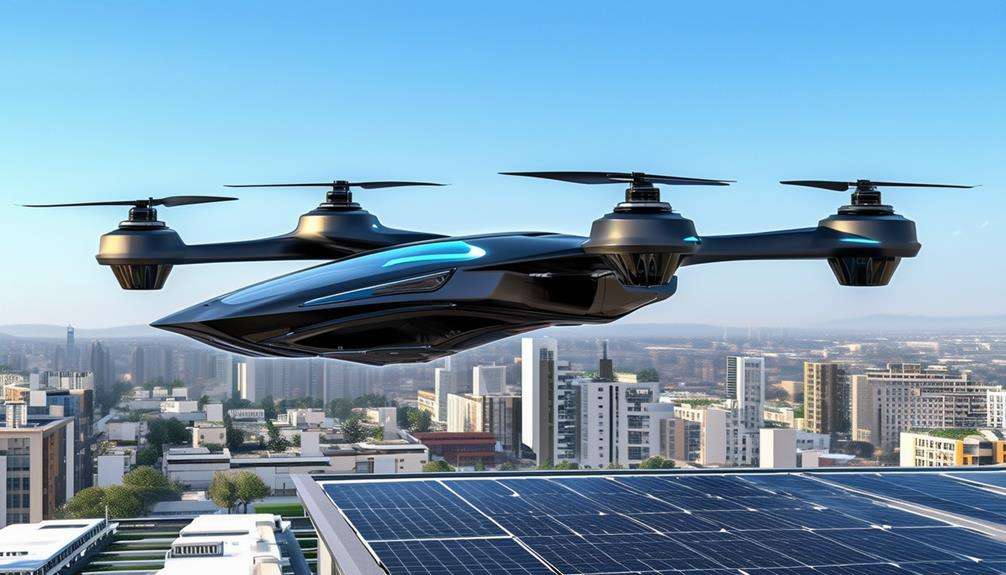
As we look to the future, VTOL (Vertical Take-Off and Landing) technology is poised to revolutionize urban transportation and beyond. Imagine flying taxis zipping through the skies, reducing commute times and alleviating road congestion. Companies like Uber and Lilium are leading this transformation, planning to introduce on-demand flying taxis that leverage VTOL technology for efficient and sustainable transportation. Urban air mobility is becoming a realistic prospect, promising to reshape how we navigate cityscapes.
NASA's advancements play a crucial role in this evolution. The battery-powered GL-10 aircraft exemplifies the strides being made in enhancing VTOL capabilities. These innovations aren't just limited to the sky; Airbus is developing hybrid drones that combine road and air functionalities, showcasing the versatility of VTOL technology.
Here's what you can expect in the near future:
- Flying Taxis: Uber aims to launch flying taxis, transforming urban air mobility.
- On-Demand Services: Lilium is working on services for quick, sustainable transport.
- Hybrid Vehicles: Airbus is prototyping flying cars for dual-mode travel.
- NASA's Contributions: Pioneering battery-powered aircraft for advanced VTOL applications.
- Sustainable Solutions: VTOL technology promises greener, more efficient transportation options.
The future of VTOL technology isn't just promising; it's almost here.
Conclusion
In summary, VTOL drones seamlessly integrate vertical lift and horizontal flight, providing exceptional versatility. By understanding their key components, take-off mechanisms, in-flight dynamics, and landing techniques, you gain insight into the intricacies and benefits of these advanced drones. With uses ranging from aerial photography to search and rescue operations, VTOL technology is revolutionizing drone capabilities, making it an exciting area of development to follow.

